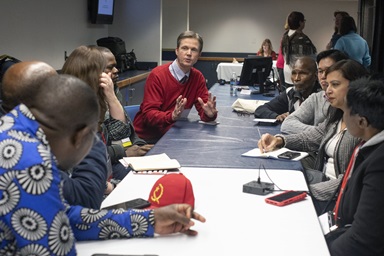Many United Methodists learned in childhood Sunday school classes that there are exactly 66 books in the Bible. Some of us even received awards for naming all the books in order, even though we had not the faintest clue what most contained. And, many of us had no idea there were other books that had not been included.
More than a half century ago, the former Methodist Publishing House produced the 12-volume “Interpreter’s Bible” (1951-57), a magisterial commentary on the 66 books.
But then a strange thing happened. As more Interpreter’s resources were prepared; the number of books in the Bible grew! The 1971 “Interpreter’s One-Volume Commentary” had a section on additional books frequently known as the Apocrypha.
Next, the “New Interpreter’s Bible” (1994-2004) included within the Old Testament the text and commentary for the majority of these books. It thus recognized works that Roman Catholics fully accept as part of the Bible, referring to them as deuterocanonical, not apocryphal.
The subsequent “New Interpreter’s Study Bible” (2003) added text and commentary for even more books, namely those accepted in Greek and Russian Orthodox Bibles. The “New Interpreter’s Bible One-Volume Commentary” (2010) followed suit.
This broader understanding of biblical content has occurred despite the fact that a United Methodist doctrinal standard, Article V of our Articles of Religion, has a list of accepted works that contains none of the additional books. This article came from The Methodist Church and had its origin in the mother Church of England.
Another doctrinal standard, our Confession of Faith, however, has an article that simply refers to “the Holy Bible, Old and New Testaments,” without naming the books that it contains. This statement continues the language of The Church of the United Brethren in Christ and the subsequent Church of the Evangelical United Brethren. After the merger in 1968 of Methodists and United Brethren, both articles about the Bible have equal authority in our denomination.
How to resolve differences
The disconnect between our publications and Article V needs to be resolved. This could be done by modifying Article V to permit United Methodists who desire to do so to accept a more extensive definition of biblical content. The process is not easy, since it involves amending our Constitution to make a restrictive rule more flexible (Paragraphs 17 and 59, 2012 Book of Discipline). There are two options to consider: one approach would expand the article; another would shorten it.
We could restore the part of the Anglican article that John Wesley removed before sending his abridged Articles of Religion to the new Methodist Episcopal Church in America. This means naming the additional books that are discussed in the 1971 one-volume commentary and declaring them, as the ancient biblical scholar Jerome did, to be worthy of reading “for example of life and instruction of manners” but not “to establish any doctrine.” Such a step would put us back in basic harmony with not only Jerome but also with the great reformer Martin Luther and with Anglican churches today, including the Protestant Episcopal Church in the United States. This action would be a limited move, and the additional books would clearly have a second-class status.
Or, we could shorten Article V to its first sentence, leaving us with a general statement about the Bible similar to that of the Confession: “The Holy Scripture containeth all things necessary to salvation so that whatsoever is not read therein, nor may be proved thereby, is not to be required of any man [sic] that it should be believed as an article of faith, or be thought requisite or necessary to salvation.” Such a broad affirmation would allow us, in our understanding of the extent of the Bible, to come much closer to agreement with Augustine, with the majority view of the Church before the Reformation and with the great majority of Christians in the world today.
This second alternative would open the door for United Methodists to appreciate more deeply differing dimensions of ancient Judaism that appear in some of the additional books and that provide essential data for understanding Jesus and much of the New Testament. Although we would lose the almost exact identification of Old Testament content with that of the Bible of the synagogue today, the potential gain in appreciation of the vitality of ancient Judaism would help to outweigh this loss.
Decision made in ‘bitterly polemical’ times
John Wesley’s apparent reason for striking the list of the works that Luther and the Anglicans, dependent on Jerome, viewed as worth reading but, strictly speaking, not part of the biblical canon, is of little guidance today. Historian Randy Maddox has recently suggested that John Wesley may have removed these books to help show that he and his brother Charles in no way supported Roman Catholic efforts to return an exiled Stuart monarch to the British throne.
Objections by some reformers to various Roman Catholic doctrines that could be supported in Jerome’s “other Books” tend to reflect a time that was “bitterly polemical.” They should hardly be considered normative today.
The part of Article V that rejects a bigger Bible should be viewed much as we now regard the more explicitly anti-Catholic articles of religion: We "are freely to relegate the polemics in these articles (and the anathemas of [the Roman Catholic Council of] Trent as well) to our memories." ("Resolution 3144, 2012 Book of Resolutions) It is worth remembering also that in his various prefaces to the apocryphal books Luther came close to admitting that some of them could well have a place in the Bible.
The preference of Jerome for the smaller, mostly Hebrew Bible, a choice that Luther and the Anglicans followed, depended in turn on decisions that had developed in Judaism before his time. These choices involved a variety of factors, such as date, supposed authorship, language and content. It is difficult to find good reasons for claiming that these ancient decisions are valid today.
Those of us who come from the Methodist wing of our denomination have been conditioned to believe that the Articles of Religion should not be tinkered with, sometimes forgetting that they are the result of Wesley’s substantial revising.
We need to remind ourselves of the precedents that The Evangelical United Brethren Church brought to its merger with The Methodist Church.
The Evangelical Association, when it adopted the Methodist articles in 1809, added one article and in 1816 removed five anti-Catholic articles. Then in the 1950s the EUB Church set the Evangelical articles aside when it prepared its Confession of Faith (Paragraph 103, pages 61-62, 2012 Discipline).
A strong case can be made for allowing United Methodists to have the option to accept a bigger Bible. The Publishing House’s offerings of outstanding biblical reference works have served and continue to serve ecumenical Christianity well. Our denomination would do well to follow suit by addressing its official positions.
*Martin is a retired elder. He was baptized and confirmed in The Methodist Episcopal Church South; was ordained in The Methodist Church and retired in The United Methodist Church. He traces his Methodist roots back to the 1830s.
Like what you're reading? Support the ministry of UM News! Your support ensures the latest denominational news, dynamic stories and informative articles will continue to connect our global community. Make a tax-deductible donation at ResourceUMC.org/GiveUMCom.




